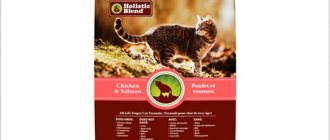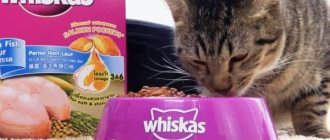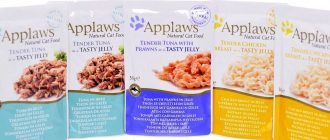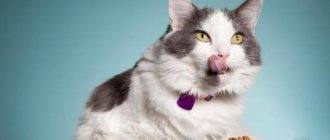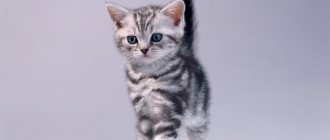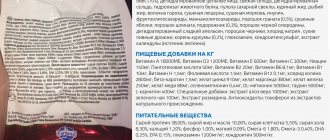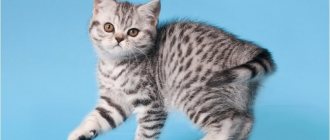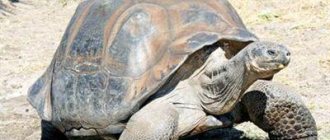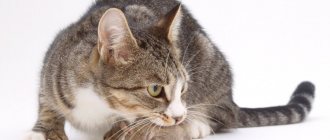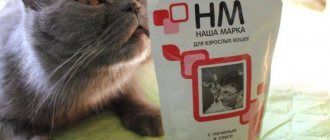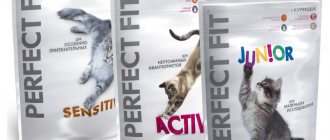Choosing the best way to feed a mustachioed pet falls on the shoulders of the person. Whiskas cat food is the most popular and affordable product intended for pets of all ages. The menu includes pillows filled with pate flavored with meat or fish, pieces in jelly, stew, and liquid cream soup. Wet and dry foods can be given at different times. You should not feed pads to cats that don't drink much. The amount of food in one meal is calculated based on the weight of the pet. Despite the fact that cats willingly eat Whiskas, veterinarians insist that it is harmful and causes serious problems with the urinary tract.
Brand history
American corporation Mars specializing in food production. In 1932, the company released cat food called Whiskas. In English, Whiskas sounds similar to Wiskers, which translated means “mustache, vibrissae.”
New formulas and formulations are developed at the Waltham research center, which is located in the United Kingdom. Thanks to the merits of researchers, the benefits of taurine for cats have been proven. The company was the first to add this substance to its animal products.
The company's factories are located all over the world. At the moment, the manufacturer has already opened several factories in the Russian Federation.
Range
Whiskas provides ready-made food for spayed and neutered cats, kittens, adult and aging pets. Whiskas for kittens is sold in the form of dry food, pouches and pate. The manufacturer claims that the composition contains everything necessary for the healthy growth of your baby.
Whiskas diets for kittens from 1 to 12 months and older cats come in a variety of flavors:
- Salmon stew is small, tender pieces of salmon in a flavorful sauce. The high content of nutrients and minerals makes the kitten food balanced.
- Rabbit and Turkey Stew is more suitable for adult cats. It contains vitamin E, which is responsible for reproductive function and oxidative processes in the body.
- Delicious stew with beef and lamb. The composition includes: by-products, ash and fiber. It is recommended to give to a cat after 1 year.
- An appetizing stew with chicken in a thick creamy sauce will give your pet an indescribable taste sensation. Cream soup from Whiskas is another new product from the company.
- An appetizing stew with rabbit is introduced into the cat’s diet after 1 year of life. With beef and rabbit, crispy pillows are available with vegetable additives.
- Turkey Jell-O provides delicious meaty turkey bites with just the right balance of minerals. The formula was specially developed for babies.
- Jelly with veal - the kitten will be happy to try small tender pieces of meat with veal. The main source of protein is beef and offal. The lean component of the feed is rice.
- Mini fillet with chicken. New product from Whiskas. Tender chicken pieces are filled with meat jelly.
- An appetizing veal pate is intended for aging animals. It does not contain grain crops, and the calorie content is 700 kcal per kilogram of weight.
Whiskas cat food
Whiskas is one of the most popular brands of cat food. The trademark is owned by Mars, and the brand representative is Masterfoods. The manufacturer claims that the food formulation was developed based on numerous studies by the Waltham Research Center and approved by the Russian Association of Veterinarians.
Whiskas is one of the leaders in the economy class cat food market
Historical note: Frank S. Mars (Minnesota) was born in 1882. He suffered from polio, so as a child he was educated at home. His mother taught him how to make chocolate, and he spent all his time in the kitchen. In 1902, he married and started his own small business selling molasses chips. After 9 years, he began making and selling chocolate bars. In 1923, Mars began to be considered a successful businessman, as his product, Milky Way chocolate, gained popularity from the first days. After this, other products began to appear, which are now still selling successfully.
In 1934, Mars died, and his eldest son, Forest, had to take over the business. It was he who decided to add pet food to the company's treasury. True, this was only possible after the war. In 1960, Forest and the company merged. The first Russian enterprise from Mars appeared in 1995 (Moscow region). This is how the organization entered the world market. After 3 years, Forest Mars passed away, but once founded, it continued to gain momentum. The products of this manufacturer are in great demand all over the world. Currently, the company has representative offices in every progressive country in the world.
In addition to Whiskas, Mars has other brands:
- Pet products: Pedigree, Royal Canin, Kitecat, Cesar, Nutro, Sheba, Chappi, Catsan, Frolic, Perfect Fit, etc.
- Chocolate brands: M&M'S, Snickers, Dove, Mars, Milky Way, Twix, Balisti, Bounty, Maltesers, Revels, etc.
- Food products: Uncle Ben's, Dolmio, Masterfoods, Seeds Of Change, Ebly, Royco, Kan Tong, Suzi Wan, Paris, etc.
- Confectionery brands: Extra, Orbit, Altoids, DoubleMint, Juicy Fruit, Life Savers, Skittles, Wrigley's Spearmint, Starburst, etc.
What class does Whiskas food belong to?
Rebranding and advertising of food may indicate that it belongs to economy class food
Cat food may fall into one of the following classes:
- economy;
- premium;
- super premium;
- holistic.
Belonging to one of these classes is determined by the quantity and quality of meat. For example, holistic food can contain up to 90% meat. We are not talking about animal proteins (offal, bone meal, etc.), but about meat (for example, fresh lamb in Akana food). Such products cannot contain dyes or flavors; they are natural and, accordingly, have a high price. You can buy such food only in specialized stores. Such a product does not need advertising, so novice cat breeders know little about such food for cats.
Super premium class has less meat content. However, the composition should predominantly contain proteins of animal origin. Some foods in this class contain flavorings and preservatives. In terms of price, they are almost no different from holistic ones.
But the premium class means cheaper products. Premium cat food can be found in a regular pet store; it may contain dyes, preservatives, and flavorings. Meat, as a rule, is about 35% in this food. Moreover, this meat may not be of the highest quality (that’s why flavorings are needed). refer their products to this class. But some veterinarians believe this is just a publicity stunt. The basis for this opinion was the analysis of the composition. In addition, usually only the simplest products need powerful and aggressive advertising, for which PR is the only way to stay in the market.
Food advertising can be very convincing, but this is not due to the high quality of the product
Economy class food contains very little meat. Moreover, these will be derivatives of meat products (animal flour, etc.). The diet will be based on grains and plant ingredients. So that the plants in the composition do not confuse the buyer, they are usually designated by a single inaccurate word - “cereals”, etc. Meat components, on the contrary, are separated in as much detail as possible so that the composition looks as if it contains a lot of products of animal origin and plant origin. There are no components at all.
The energy value in this food is achieved thanks to vegetable proteins (corn gluten, etc.). There will also be no special components (for example, fruits or rare herbs) in such a product. There will be a bare minimum of vitamins and mineral components. The food will contain coloring (to give it an appetizing appearance), preservatives (since low-cost production technologies do not allow for long-term storage) and flavorings (otherwise the cat may simply refuse such food). Moreover, the “smallest” components in the form of, for example, dyes may not be indicated (so as not to frighten buyers with the abundance of the letter E in the composition).
One of my friends buys only cheap food for her cat. But at the same time, she studies the label every time for half an hour, claiming that she strictly follows the rules of the diet - how much protein a cat should receive and how much carbohydrates. In fact, cats (and they are natural predators) need animal protein. Even if these are just processed meat products, they are better than vegetable protein. In addition, my friend does not take artificial ingredients into account (I am usually confused by the fact that the percentage of an undesirable ingredient is not indicated).
When choosing food, you should always study the composition of the product (it is always indicated on the packaging - on the back or side)
Analysis of dry food composition
The company produces only one type of Whiskas dry food for kittens - air pads. Manufacturers do not hide the fact that dry food contains various types of flour, the mass fraction of which is at least 4%, and by-products. This recipe makes the food grain-based and lacks the required amount of protein. Manufacturers also add brewer's yeast, animal fat and vegetables to Whiskas.
Whiskas dry food helps prevent the formation of tartar and the development of gastrointestinal diseases in kittens.
Feeding standards
Until the kitten reaches 12 months of age, it should only be given kitten food.
To determine the daily and single dose, you need to know the weight of the animal. The norms are calculated to cover all the nutritional needs of the cat, but Whiskas is not a complete food in composition, so the portions are larger than those of premium foods. With a mixed diet, dry and wet foods are divided into several meals. The box or packaging contains information about the amount of food calculated for the pet's weight. The norm can be adjusted based on the needs of the pet. When feeding dry food with meat or fish, you need to make sure that the amount of water you drink is three times the serving of pads. One-time standard factory food for the weight of an adult pet
| Cat weight, kg | Calories per day | Dry form, gram | Wet, gram |
| 2—3 | 170 | 45 | 200 |
| 4—5 | 250 | 55 | 250 |
| 5—8 | 300 | 65 | 300 |
Wet food composition analysis
The composition of Whiskas food in pouch is different from dry food and contains only a few components. Mass fraction of meat and offal - 8.5%. The cereal components make Whiskas rich in carbohydrates. Taurine, vitamin and mineral complexes maintain the natural balance of the body.
Whiskas wet cat food is considered an economy class food. The factory packaging of the jelly does not indicate the exact amount of meat, its type, or which by-products were used in the feed compositions.
The manufacturer does not inform consumers about which specific products are used in wet food - high-quality or potentially dangerous.
The attitude of veterinarians to Whiskas food
Whiskas's circle of veterinarians claims that as long as this brand is sold, they will have work. The day of the death of Mars products will become black for the entire veterinary industry.
Whiskas is a synonym for the word “poison, toxin”; its use leads to the death of millions of consumers, and also causes dire consequences:
- - urolithiasis;
- -dermatitis, allergies, diathesis;
- - constipation, enteritis, diarrhea, gastrointestinal disorders, enteritis, colitis, gastritis;
- - loss of whiskers and fur;
- - liver diseases;
- - inflammation in any areas.
The most “terrible” consequence of taking whiskey is the most delicious (in the animal’s opinion) ingredients, which are sure to be addictive. These components are the strongest flavors and dyes that are so attractive to cats. “Try to switch your pet to a high-quality diet rather than an economy-class diet.” Attractant substances are a secret and almost narcotic component of food; their use makes your pet dependent on a particular brand of food.
Is Whiskas harmful for cats and kittens? Is it possible to feed a cat Whiskas?
The question regarding the harm/harmlessness of Whiskas worries many owners of furry pets. Cat lovers and veterinarians have differing opinions on this issue. Some experts claim that Whiskas is not just harmful, but also very dangerous for the health of cats. Others note that pets can live “on Whiskas” for a long time, without any health problems. To understand this topic, you should study the composition of Whiskas, its effect on the cat’s body, properties and characteristics.
How to wean a cat off Whiskas
It has been proven that Whiskas is often addictive and even somewhat addictive in cats. What to do if the animal eats only Whiskas and flatly refuses any other food? In this case, veterinarians suggest gradually weaning your pet off such a harmful product. For these purposes, it is recommended to gradually add other foods to the food.
You should start with minimal dosages, unnoticed by the animal itself. It is gradually recommended to increase the percentage of natural products in the diet. Thus, in a few months you can absolutely calmly and painlessly wean your cat off Whiskas by switching it to healthy, natural food.
Disadvantages: save on health
How good is Whiskas? Reviews indicate that all economy-class food is of rather low quality. It is worth noting that there are still cheap options on the market that are significantly inferior to Whiskas in terms of the content of nutrients. You should be especially careful when buying unknown brands and brands produced by retail chains. Always read the ingredients before purchasing!
Another disadvantage can be considered the high price for canned food, taking into account the high water content and far from ideal composition.
Reviews from professional breeders and veterinarians are not reassuring - low-quality food can cause numerous gastrointestinal diseases and allergies in cats. The animal's kidneys and liver are especially at risk. Veterinarians are increasingly citing cheap, low-quality food as the cause of urolithiasis. Trying to save money on your cat's food can have a detrimental effect on your pet's health and lead to its death. Do not forget that the animal must be regularly shown to the veterinarian and, if necessary, tests done.
What are the consequences
Feeding your pet with ready-made food is quite simple, quick and inexpensive. However, few owners think about the possible consequences of such a diet for their pet.
Veterinarians point to the following diseases and pathological conditions that develop in cats whose menu is based on Whiskas and other economy-class foods:
- gastritis;
- ulcerative lesions of the gastrointestinal tract;
- bouts of vomiting;
- liver pathologies;
- development of dependence on food, refusal of other foods;
- kidney diseases;
- sand and stone formations localized in the kidney area;
- hair loss;
- skin, dermatological diseases;
- lethargy, passivity;
- development of obesity;
- the appearance of dandruff and skin rashes;
- pancreatitis.
Clinical studies have shown that cats fed Whiskas require more water. Thus, when eating 100 g of food, an animal must consume at least 250 ml of liquid, which is virtually unrealistic. Lack of proper drinking regime leads to serious problems with the kidneys and urination, increased urine concentration, and the formation of sand and stones.
If you constantly feed Whiskas to a small kitten, you can provoke delays in its development, a weakened immune system and an increased susceptibility to various kinds of diseases. Possible unwanted side effects include allergic reactions.
The results of the studies have proven that domestic cats that feed exclusively on Whiskas and often consume this food live on average no more than 5 years. At the same time, the average life expectancy of cats whose owners provide an optimally balanced menu is at least 10-15 years.
